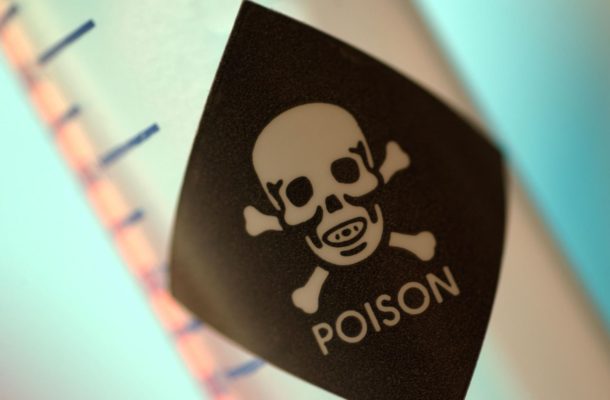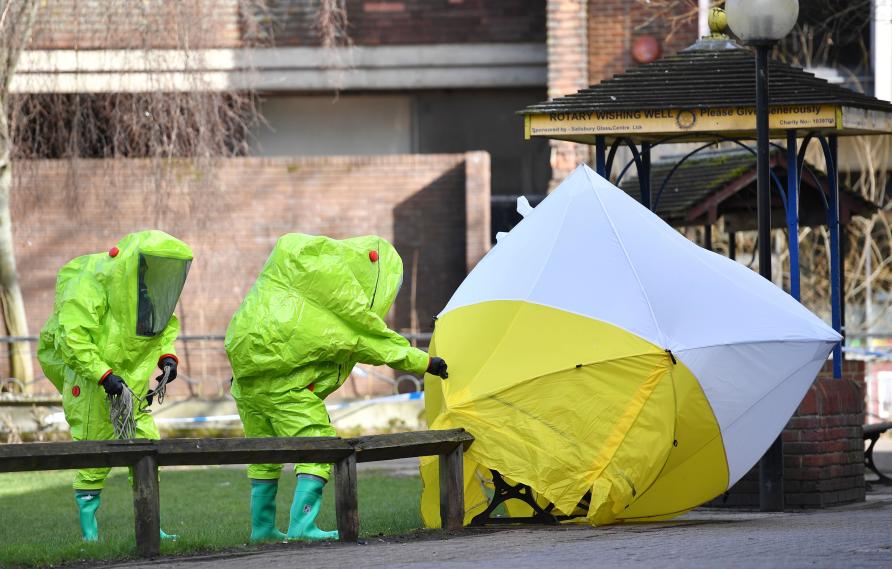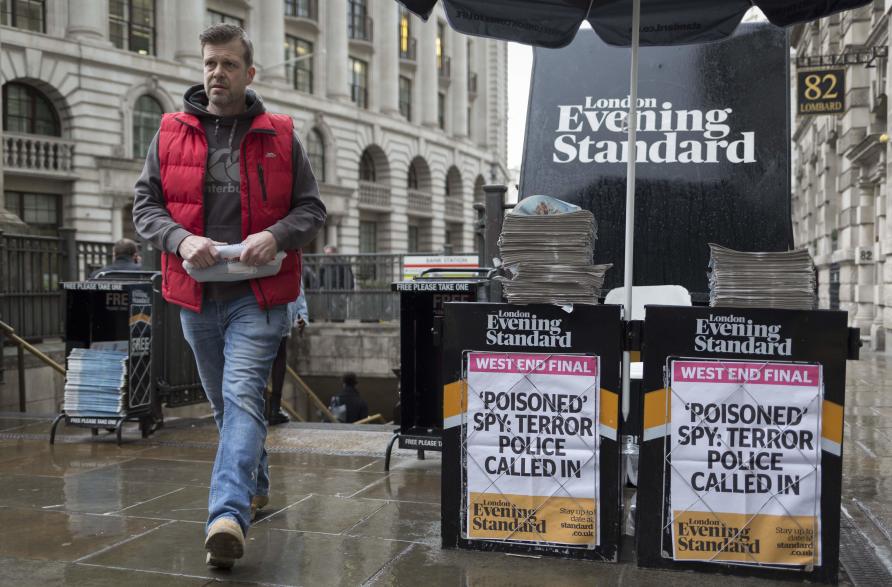The deadly science behind Russian nerve agent Novichok

British Foreign Secretary Boris Johnson says the Government has evidence Russia has been creating and stockpiling the deadly nerve agent Novichok within the past decade.
Former Russian spy Sergei Skripal, 66, and his daughter Yulia, 33, remain critically ill after they were poisoned by a chemical that is part of a group of nerve agents known as Novichok earlier this month in Salisbury, in the United Kingdom.

The case marks the first use of a nerve agent on European soil since World War II.
So, what do we know about Novichok and where it came from?
We asked George Braitberg AM, a Professor of Emergency Medicine at the University of Melbourne, who’s also an expert in Emergency Toxicology, to give us some scientific insights into the agent and its development.
Q1: What is Novichok?
Novichok is a class of nerve agents that are acetylcholinesterase inhibitors, which can occur naturally in some venom and poisons. These inhibitors are chemicals whose primary toxic effect is to block the normal breakdown of the neurotransmitter, acetylcholine – more on that a bit later.
The agent is reportedly between five to eight times more lethal than VX (or “venomous agent X”) nerve agent, which was used to kill the brother of North Korean leader, Kim Jong-Un, in Malaysia in 2017. Novichoks’ effects are rapid, usually felt within 30 seconds to 2 minutes.
In practice, Novichok is a group of agents modelled on VX with different chemical group substitutions that increase its lethality – VR, Substance 33, A-232 and 234 are all Novichok types. They are sometimes attributed with a number, for example, Novichok-5 is actually A-232.
Originally, these agents were developed in an attempt to circumvent the Chemical Weapons Convention, which officially came into force in 1997, that bans chemical weapons and their precursors.
At the time, the Soviets argued that the treaty exempted novel or new agents not listed in the schedule of chemicals – and so the name Novichok actually translates to “newbies.”

Q2: How does a nerve agent like Novichok work? On the body? On the brain?
Acetylcholine (Ach) is one of the most important neurotransmitters in our body’s autonomic and somatic nervous systems. The autonomic nervous system is responsible for the “automatic nervous functions” such as the control of our pulse and blood pressure, bladder and bowels, secretions and breathing reflexes.
The somatic nervous system is the interface between our nerves and muscles, modulating muscle strength and their response, which affects most areas of the body.
By inhibiting the breakdown of Ach, there’s an increase its concentration and subsequent activity leading to the wide variety of symptoms that we see in Novichok poisoning. For example, excessive stimulation of secretions can obstruct the airway, while excessive stimulation of the nerve supply to muscles will lead to fatigue and paralysis. Both of which can result in death.
Q3: How was it discovered? How is it made?
Evidence for the existence of these agents was provided by former Russian analytical chemist Vil Mirzayanov, who worked for the State Research Institute of Organic Chemistry and Technology during the Soviet era.
According to the chemist, the Russian program employed as many as 30,000 or 40,000 people, including around 1,000 who worked specifically on Novichok. He also claims that the program produced tonnes of the agent – something Russia has not commented on.
Dr Mirzayanov went public in 1992 detailing the chemical weapons program, codenamed Foliant, which ran from the 1970s through to the 1990s. Following publication of the story in the Moscow News, he was imprisoned, but following pressure from Western officials the charges were eventually dismissed. Dr Mirzayanov immigrated to the United States where he documented the program in much more detail.

The basic structure of the Novichok nerve agents is an organophosphorus core. Organophosphates are commercially used as insecticides, but nerve agents are much more potent and hence lethal. This deadliness is amplified by the rapid onset of symptoms and environmental persistence.
Survival is really dependent on the amount of exposure to the chemical. The main route of exposure is thought to be through inhalation, although absorption may also occur via skin or mucous membrane exposure. Typically, dermal exposure takes longer to reach toxicity as the agent needs to be absorbed through the skin which forms a natural barrier.
Nerve agents can also be consumed, and there is some conjecture that this could be the case in Salisbury, but this route of delivery isn’t well studied. There’s also speculation that the pair could have been exposed to the deadly nerve agent through his car’s ventilation system.
Once in the system, Novichoks cause secretions and spasms that block the airway leading to asphyxiation, which is usually the cause of death. Later paralysis of the respiration muscles also lead to the same outcome.
There are antidotes available that can improve the chances of survival, but given the rapid onset of symptoms, the overriding factor determining survival is the size of the dose the victim received.
Q4: Have Previous victims who survived gone onto have health problems?
According to Dr Mirzayanov, Novichok was designed to do “irreparable” damage to the human body.
The chemist has recounted a story of his colleague Andrei Zheleznyakov, who was accidentally poisoned by a Novichok agent. Although he received an antidote, Dr Zheleznyakov suffered ongoing depression, epilepsy, and liver problems before his death five years later. However rigorous scientific studies on long-term subsequent illnesses are lacking.
Important in this most recent case is ensuring bystanders and rescuers don’t become secondary casualties by entering the toxic zone – this is very difficult to control and is a concern for all Hazmat (hazardous materials) situations.

As a result, Public Health England issued a warning following discovery of trace contaminants. While no immediate health risk to anyone has been identified, there was a small chance that any of the agent that came into contact with clothing or belongings could still be present in minute amounts and contaminate skin.
Q5: How is Novichok delivered?
Nerve agents have a variety of delivery methods. Sarin, for example, typically comes in the form of a gas or vapour. VX, the nerve agent used in the death of Kim Jong-Nam, was delivered via aerosol or spray.
But Novichok agents can be delivered in a solid form, most likely a powder.
Novichok agents may consist of two separate ‘non-toxic’ components that, when mixed, become the active nerve agent – so called binary chemical weapons. This allows the raw ingredients to be handled without the need for personal protective equipment (PPE).
Although the materials needed to make the nerve agent are cheap and relatively accessible, transforming them into a deadly weapon requires specialised expertise and a lot of safety precautions.
But it’s important to note that a lot of knowledge in this area remains speculative, primarily because the Novichok family of nerve agents was specifically created by Russia, so no standard test exists for Novichoks, in the West.
This article was published by Pursuit. Read the original article.
Professor George Braitberg is the Executive Director of Strategy, Quality and Improvement at Melbourne Health. He is also a Professor of Emergency Medicine at Melbourne University.














Amelia
March 25, 2018 at 4:03 pm
Putin is such a vicious thug. It’s not just that he tries to murder people on the streets on Britain as shamelessly as he does the streets of Moscow, but that he uses such a tell tale method to try to intimidate his political foes at home and abroad as well as other nations. This maniac would pave the world in corpses to rebuild the Soviet Union if he could. There’s a thousand ways to kill someone, it doesn’t really matter how he does it, only that he does and thinks he can get away with it. One day let’s hope this catches up with him.
Alan Stevenson
March 26, 2018 at 9:02 am
We must be careful not to take a ‘holier than thou’ approach to the concept of nerve agents. I recall that in November 1958 a leak developed in a depot in South Australia, killing a number of sheep. In the early 1960’s the Royal Australian Navy contemplated issuing ships with 4.5 inch shells containing VX but decided against it due to worries about storage.
We almost certainly have small amounts in North Queensland used to test the various creams, antidotes and clothing being developed to combat the menace. The fact that we still research the ABCD (anti biological, chemical defense) capabilities indicates that we recognise that there is still a menace even if we are not (hopefully) perpetrators.
Amelia
March 26, 2018 at 10:49 am
We don’t use nerve agents to murder political opponents on the streets of foreign nations. Contemplating having them 60 years ago and using them today are two entirely different things. The only reason we have to research ways to counter them – and I’m glad we do – is because rogue states like Russia are using them to murder people today.